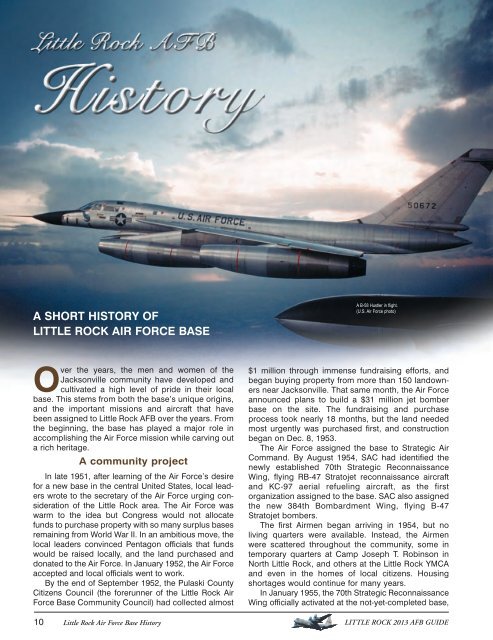Little - Keep Trees
Little - Keep Trees
Little - Keep Trees
Create successful ePaper yourself
Turn your PDF publications into a flip-book with our unique Google optimized e-Paper software.
A SHORT HISTORY OF<br />
LITTLE ROCK AIR FORCE BASE<br />
Over the years, the men and women of the<br />
Jacksonville community have developed and<br />
cultivated a high level of pride in their local<br />
base. This stems from both the base’s unique origins,<br />
and the important missions and aircraft that have<br />
been assigned to <strong>Little</strong> Rock AFB over the years. From<br />
the beginning, the base has played a major role in<br />
accomplishing the Air Force mission while carving out<br />
a rich heritage.<br />
A community project<br />
In late 1951, after learning of the Air Force’s desire<br />
for a new base in the central United States, local leaders<br />
wrote to the secretary of the Air Force urging consideration<br />
of the <strong>Little</strong> Rock area. The Air Force was<br />
warm to the idea but Congress would not allocate<br />
funds to purchase property with so many surplus bases<br />
remaining from World War II. In an ambitious move, the<br />
local leaders convinced Pentagon officials that funds<br />
would be raised locally, and the land purchased and<br />
donated to the Air Force. In January 1952, the Air Force<br />
accepted and local officials went to work.<br />
By the end of September 1952, the Pulaski County<br />
Citizens Council (the forerunner of the <strong>Little</strong> Rock Air<br />
Force Base Community Council) had collected almost<br />
10 <strong>Little</strong> Rock Air Force Base History<br />
A B-58 Hustler in flight.<br />
(U.S. Air Force photo)<br />
$1 million through immense fundraising efforts, and<br />
began buying property from more than 150 landowners<br />
near Jacksonville. That same month, the Air Force<br />
announced plans to build a $31 million jet bomber<br />
base on the site. The fundraising and purchase<br />
process took nearly 18 months, but the land needed<br />
most urgently was purchased first, and construction<br />
began on Dec. 8, 1953.<br />
The Air Force assigned the base to Strategic Air<br />
Command. By August 1954, SAC had identified the<br />
newly established 70th Strategic Reconnaissance<br />
Wing, flying RB-47 Stratojet reconnaissance aircraft<br />
and KC-97 aerial refueling aircraft, as the first<br />
organization assigned to the base. SAC also assigned<br />
the new 384th Bombardment Wing, flying B-47<br />
Stratojet bombers.<br />
The first Airmen began arriving in 1954, but no<br />
living quarters were available. Instead, the Airmen<br />
were scattered throughout the community, some in<br />
temporary quarters at Camp Joseph T. Robinson in<br />
North <strong>Little</strong> Rock, and others at the <strong>Little</strong> Rock YMCA<br />
and even in the homes of local citizens. Housing<br />
shortages would continue for many years.<br />
In January 1955, the 70th Strategic Reconnaissance<br />
Wing officially activated at the not-yet-completed base,<br />
LITTLE ROCK 2013 AFB GUIDE
















